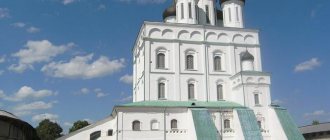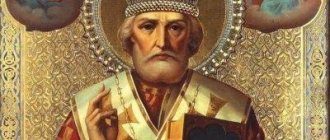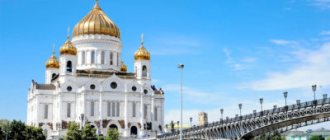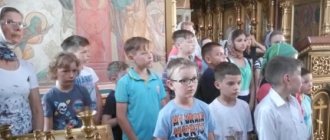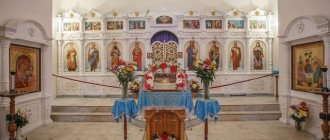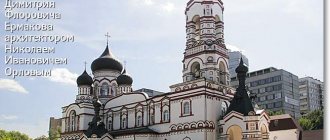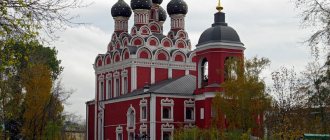Website: hram-paraskevo.ru
Postal address: 129626, Moscow, Droboliteiny lane, 5, building 1.
Art. metro: Alekseevskaya, Rizhskaya.
Telephones; (mobile).
View the schedule of services
Altar(s): main - the Life-Giving Trinity, chapels - St. Paraskeva of Serbia, St. Sergius of Radonezh.
Shrines
The mother of St. Philaret (Drozdov), Evdokia Nikitichna (+1853), is buried in the Trinity Church; there is a memorial plaque above the burial place. The icons, as well as some of the utensils, are mostly from the same time as the temple. There are icons and spiritual paintings in the church that were donated by parishioners in the pre-revolutionary period.
- A reliquary with a reliquary cross and particles of the relics of saints, located above the burial place of the mother of St. Philaret (Drozdov). The cross contains: the wood of the Holy Cross, the stone of the Holy Sepulcher, particles of the relics of the first martyr. Archdeacon Stephen, right. Lazarus, saints: John Chrysostom, Athanasius the Great; Rev.: Ephraim the Syrian, Herman of Sviyazhsk; holy martyr: Basil of Paria, Basil of Amasia; great martyr: Theodore Tyrone, Theodore Stratilates, George the Victorious, healer Panteleimon, Demetrius the myrrh-streaming; martyr: Ermolai, Cyriacus, Mercury, Eugene, Orestes, Procopius, Andrian, Nikita. In the reliquary next to the cross there are: particles of the relics of the Apostle and Evangelist Mark, the Apostle Andrew, the saints: Polycarp, Clement; saints: Basil the Great, Gregory the Theologian, John Chrysostom, Nicholas, Cyril, Spiridon, Philaret of Moscow (Drozdov); Rev.: John of Damascus, John the Merciful, Great Martyr: Barbara, Panteleimon, Theodore Tyrone; martyrs: Nikita, George, Cyriacus, Victor, Hypatius, Eugene (of the five), Eugene; martyrs: Irene, Eugenia, Maria, Justinia, Ven. Paraskeva, relics of many saints.
- The altar image of the Resurrection of Christ is a monumental mosaic of the late 19th – early 20th centuries, the iconography repeats the famous painting composition of M.V. Nesterov, located in the Vladimir Cathedral in Kyiv;
- In the Calvary of the Crucifixion of the Lord in the main chapel of the Trinity Church (on the right) a stone was inserted, brought in 2000 from the Holy Land from the Mount of Temptations.
Used materials
- Temple page on the website "People's Catalog of Orthodox Architecture"
- Elena Lebedeva Trinity churches of old Moscow
- Website of the Moscow Trinity Church on Sparrow Hills:
[1] Golubtsov Sergius, protode. Church Muscovy in 1935-1965. // Church Historical Bulletin. M., 2004. No. 11. P. 4-71. Appendix No. 3, No. 334, Yakov Krotov Library website,
[2] “Rectors”, official website of the Church of the Dormition of the Mother of God in Veshnyaki,
[3] Priests of the Trinity Church on Vorobyovy Gory in the 19th - 20th centuries. —
How to get there by car:
From the center: cross Krestovsky Bridge along Prospekt Mira, turn right, then (before reaching the traffic light) left.
From the region: take Mira Avenue to Krestovsky Bridge, make a U-turn under the bridge.
And about. rector: Archpriest Andrey Pashnin
Clergyman
- Archpriest Nikolai Farkovets
- Priest Vitaly Konoval
- Protodeacon Alexy Krivolapov
Divine services: daily - Matins and Liturgy at 8.00, on Sundays - at 9.00, on the eve of Sundays and holidays - all-night vigil at 17.00.
On Sundays at 16.00 an akathist is performed by St. Paraskeva Serbskaya (Paraskeva-Petka).
The church has a youth club, an Orthodox children's club, a club for adult parishioners, and pilgrimages are made to holy places in nearby regions.
Abbots
- Nikifor Vasiliev (mentioned 1765 - 1768), the last rector of the wooden church
- Yakov Ilyin (1802 - November 1829), first rector of the stone church
- sschmch. Andrey Voskresensky (? - 1935)
- Mikhail Morozov (1935 - ?)
- Alexander Lyovochkin [1] (1945 - 1953)
- Victor Konoplev (December 1953 - 1956)
- Vasily Svidenyuk (1956 - 1957)
- Vadim Grishin (1957 - 1961)
- Arkady Stanko (1961 - 1963)
- Victor Ippolitov (1963)
- Victor Dmitriev [2] (1963 - 1970)
- Vladimir Rozhkov (1970 - 1971)
- Vasily Ostalsky (1971 - March 16, 1982)
- Sergiy Suzdaltsev (March 16, 1982 - March 16, 2014)
- Gennady Borozdin (February 12, 1985 - March-April 1987 [3]) acting
- Andrey Novikov (May 21 - June 19, 2014) acting
Temple-chapel in honor of sschmch. Simeon, bishop Persian
Directions: the same as to the Church of the Life-Giving Trinity at Pyatnitskoye Cemetery. You can get to the chapel along the main path of the Pyatnitskoye cemetery: straight from the gate, go around the main temple on the right.
Architectural style: neo-Russian style.
History: The temple is located in the center of the Pyatnitskoye cemetery. Pyatnitskoye Cemetery was founded in 1771 during the plague epidemic. The first wooden church on this site was erected in honor of St. Paraskeva of Serbia in 1772, consecrated on December 25 (Old Art.) In 1837, it was broken due to disrepair, and in its place, according to the design of the architect. Nikolai Ilyich Kozlovsky a wooden chapel was built. In 1915–1917, when the chapel also fell into disrepair, at the expense of one of the custodians of the Pyatnitsky cemetery, Semyon Semyonovich Zaitsev, in the same place according to the design of the architect. Nikolai Nikolayevich Blagoveshchensky built a stone temple-tomb in honor of the Sschmch. Simeon, bishop Persian. The new church was assigned the same functions as the old wooden chapel (coffins with the bodies of the deceased were delivered there until the time of burial, ordered masses, memorial services and funeral services were served). A tomb for the Zaitsev family was built under the temple. In 1920, the temple was closed, and cemetery equipment began to be stored in its premises. In 1930–1970 the temple was significantly destroyed, and when it was returned to the Church of the Holy Trinity, it was restored. On October 27, 2000, the temple was consecrated by the Great Hierarchal Order of Patriarch of Moscow and All Rus' Alexy II.
The Church of the Life-Giving Trinity at Pyatnitskoye Cemetery needs help!
Temple details
Local religious organization Orthodox parish of the Church of the Life-Giving Trinity at the Pyatnitskoye cemetery in the mountains. Moscow, Moscow Diocese of the Russian Orthodox Church (Moscow Patriarchate).
INN 7717079864 KPP 771701001
Bank branch: GPB (OJSC) Moscow
R/ac. 40703810892000001259
Cor/ac. 30101810200000000823
BIC 044525823
Purpose of payment: Donation for general church needs
Moscow.org Moscow city portal
| All photos |
Address: st. Kosygina, 30 (University Square, 1)
Telephone
How to get to the Church of the Life-Giving Trinity on Vorobyovy Gory: Art. metro: University
The Church of the Life-Giving Trinity on Sparrow Hills in Moscow has an ancient history. In addition to the main Trinity altar, there are three chapels in the church: in honor of St. Nicholas the Wonderworker, Sergius of Radonezh, Agapius and Jonah.
The appearance of the Trinity Church in this place is associated with the ancient palace village of Vorobyovo, which has been mentioned in chronicles since the mid-15th century. It is known that in the 50s, the wife of Moscow Grand Duke Vasily I, Sofya Vitovtovna, became its owner. It is believed that the previous owner of the village was a priest named Vorobey, which is where the name of the village came from. But in the “History of Moscow Districts” it is stated that the name arose from the names of the sons of the owner of local estates, boyar Andrei Kobyla.
Already in those years, Vorobyovo was called a village, and this indicates the presence of an Orthodox church. Perhaps the Trinity Church was the summer home church of the great Moscow princes. In the chronicles of 1644, the Church of the Life-Giving Trinity is described as very ancient, but it is known that before it there were already 2 or 3 churches on this site, dilapidated and dismantled, and instead of them one was built - Trinity with chapels.
The village of Vorobyovo was very loved by the father of Ivan the Terrible, Grand Duke Vasily III. According to legend, in 1521, when Mengli-Girey attacked Moscow, the Grand Duke hid in a haystack, near a wooden palace, and thanks to this he remained unharmed. From here the prince went hunting near Volokolamsk, where one day he became seriously ill. The seriously ill Vasily III spent two days in Vorobyovo - the ice on the river had not yet risen, and a bridge was hastily built in order to transport the Grand Duke to Moscow. When the bridge was finally ready, and the prince was crossing the river in a cart, the crossing collapsed, and only by a miracle did the sovereign survive. It was possible to cross the river only by ferry from Dorogomilov. The very next day after arriving in the Kremlin, December 3, 1533, the Grand Duke died. His heir, the future Tsar Ivan the Terrible, was not yet four years old.
At the age of 17, the young Grand Duke, recently crowned to the throne, waited in the palace on the Sparrow Hills for the terrible fire that raged in Moscow in the summer of 1547. The rebellious people rushed from Moscow to the royal residence, but were stopped by cannons. Later, both Boris Godunov and Peter I favored the Vorobyovsky Palace. Empress Catherine II also loved to relax in the palace, but at the end of her reign the palace fell into disrepair and was dismantled.
Twenty years later, on the Sparrow Hills, under the patronage of Emperor Alexander I, according to the design of the architect A. Vitberg, construction of the Cathedral of Christ the Savior began.
The current Trinity Church on Sparrow Hills was built in 1811-1813. The church is a quadrangular building in the style of classicism. This is a single-domed temple with a portico and columns, as well as a two-tier bell tower. In 1812, before the council in Fili, M.I. prayed in this church. Kutuzov. The church survived the Napoleonic invasion, and what’s more, Napoleon himself visited it when he came to Vorobyovy Gory to inspect the panorama of Moscow. According to some reports, the famous “holy doctor” F. Haas played an important role in the construction of the new Trinity Church on the Sparrow Hills. The fact is that the prisoners of the local transit prison, who lived in former construction barracks built for the builders of the Cathedral of Christ the Savior, did not have their own church. Haaz advocated for prisoners to be assigned to Trinity Church and be able to attend services. In the period before 1917, the church was renovated twice: in 1858-1861 and in 1898.
The Trinity Church on Vorobyovy Gory survived during the Soviet period, despite the fact that the dachas of Lunacharsky and Khrushchev were located here in different years. In plans for the revolutionary transformation of Moscow, Vorobyovy Gory occupied one of the first places. After the death of V.I. Lenin, they were renamed the Lenin Mountains, and here they planned to erect a monument to the leader of the world proletariat, as well as build a palace in his honor. But these and many other plans were never destined to come true. Even when bell ringing was banned throughout Moscow, this did not affect the Trinity Church on Sparrow Hills - it was located outside the city limits. It is surprising that the temple was not closed even when after the war, in the late 40s, it was decided to build the main building of Moscow State University here. The ancient interiors of this church have been preserved to this day. In 1964, the church was restored from the outside, and in 1971-1972 a comprehensive renovation of the building was carried out.
In the Trinity Church on the Sparrow Hills such Orthodox shrines are kept as: the icon of the Mother of God “Gracious Heaven”, icons of the 17th century: the Lord Pantocrator with the marks of the Crucifixion and Resurrection, the “Passionate” Mother of God, John the Baptist, the apostles John, Peter, Paul, Matthew icons 19th century: Holy Trinity of the New Testament, Guria, Samon and Aviv, Cosmas and Damian, Holy Trinity (17th century), “Burning Bush”, Kazan Icon of the Mother of God, “Quench My Sorrows”, four-part icon of the 19th century. - The Nativity of Christ, the Mother of God, John the Baptist and St. Nicholas the Wonderworker.
Temple Information
The wooden Trinity Church on the Sparrow Hills has existed since ancient times and is associated with the history of the ancient palace village of Vorobyovo. According to the chronicle, it is known that when in the 15th century the village was bought by Grand Duchess Sofya Vitovtovna, the wife of the Moscow Grand Duke Vasily I and the daughter of the Grand Duke of Lithuania Vitovt, the temple was already standing.
The first priest of the wooden Trinity Church known to us was Fr. Titus, who was abbot from 1628 to 1632. According to the parish books of the Patriarchal Treasury Order of 1628, the Wooden Trinity Church in the village of Vorobyovo was listed among the “residential” Moscow churches - “beyond the Wooden City”. Until 1690, the Trinity Church was built in the Prechistensky Forty of Moscow, and from 1691. it was already written in the Zagorodskaya Tithe. By the end of the 1790s, the temple had become very dilapidated and was dismantled by order of Catherine the Great. The last priest of the wooden Trinity Church was Father Nikifor Vasiliev.
The current brick church with a white stone plinth was built in 1811 according to the design of the architect A.L. Vitberg, the author of the design of the temple-monument of Christ the Savior on Sparrow Hills. The building was built in the style of late classicism, as stated in the documents “... through the diligence of parishioners and willing donors...” The first rector of the stone church was Father Jacob Ilyin. The stone temple was erected near the previous wooden one. In 1811, a crowned one was installed on the site of the altar of the old church. cross is a white stone monument that has survived to this day. The porch in front of the entrance on the western facade of the bell tower and extensions on its sides appeared during renovations of the building in 1858-61 and 1898. The territory of the church is surrounded by a brick fence of the late 19th - early 20th centuries. with metal grille.
In 1812, M.I. Kutuzov prayed here before the council in Fili. The building survived the Napoleonic invasion.
Until 1818, the temple was listed among the churches of the Moscow district, and from March 30, 1818, in the Zamoskvoretsky forty of Moscow.
Trinity Church not only escaped socialist destruction, but was not even closed during Soviet times, so its ancient interior has been preserved. Moreover, after the well-known Bolshevik ban on bell ringing throughout Moscow, it was in the Vorobyov Trinity Church that the bells continued to ring and Orthodox Muscovites secretly went to listen to the blessed ringing of its bells. Once again, the church survived the construction of a high-rise building at Moscow State University in the late 1940s and early 1950s.
Now the temple on the Sparrow Hills has, as before, three chapels - in honor of the Holy Trinity, St. Nicholas the Wonderworker, and St. Sergius of Radonezh. There is also a side altar of St. Jonah, Metropolitan of Moscow, which is located in the altar of St. Nicholas.
The temple belongs to the Mikhailovsky Deanery of Moscow.
Shrines: In the temple there are icons of the 19th century - “Saints Gury, Samon and Aviv”, “Saints Cosmas and Damian”, “The Burning Bush”, “Joy of All Who Sorrow”, the “Kazan” icon of the Mother of God, a four-part icon - with images of the Nativity of Christ , the Nativity of the Blessed Virgin Mary, the Nativity of John the Baptist and the Nativity of St. Nicholas the Wonderworker, the icon of the “Savior Not Made by Hands” from the school of Simon Ushakov. The revered icon of the Mother of God - “Blessed Heaven”. Ancient icons: a revered copy of the miraculous icon of the Mother of God “Donskaya” and holy. Nicholas with his life. In the temple there is a reliquary with particles of the relics of saints: St. Mitrophan of Voronezh, Righteous Alexy (Mechev) and Blessed Matrona of Moscow.
Baptism of a child in the Church of the Nativity of the Mother of God on Krylatskie Hills
A slideshow from a photo of a child’s baptism in the Church of the Nativity of the Mother of God in Moscow, set to a beautiful melody, retains in the memory of the baptized person, the godparents, and all other witnesses to the sacrament the brightest moments of the ceremony. Here there is immersion in a font with holy water, anointing with oil consecrated in a special way, happy and slightly excited faces of parents and godparents, general photos both inside the temple and at the entrance to the church. The slideshow is compiled from original photos and from collages and photographs in stylized processing.
